
Many pets, like their owners, are more active in the summer. Especially those who tend to hibernate during the snowier months. Simple logic might tell you that more activity means your pet needs more calories. So, should you switch to a summer pet diet? In most cases, it’s not necessary.
Seasonal appetite changes
Ever notice how you crave heavier “comfort” foods like lasagna in the winter but opt for lighter salads in the summer? The same phenomenon can occur in pets, too.
A study of 38 free-fed cats found that they chowed down the most food between October and February and ate about 15 percent less from June through August.
In the winter months, dogs that are outdoors a lot need about 7.5 percent more calories for every 10-degree drop in the temperature to help them generate heat. The opposite is also true: in warmer temperatures, they tend to need about 7.5 percent fewer calories for every 10-degree increase in temperature.
That said, if your dog is involved in any high-intensity sports or competitions over the summer, it’s best to confer with your veterinarian about your pet’s nutritional needs.
In most cases, no diet changes are necessary
Rather than switching your pet to a “lighter” diet, a better option might be to feed your pet a slightly smaller amount. Again, your veterinarian can help you determine how many calories your pet needs in the summer.
You generally want to keep your pet’s diet consistent unless he or she has a special health condition such as allergies, obesity or arthritis that can be helped with a dietary change. In those cases, you want to make a gradual switch to the new diet because abrupt changes can lead to tummy upset, vomiting and diarrhea.
Monitor your pet’s figure
One of the best ways to tell if your pet is eating the right amount is by using a body condition scoring system. Ideally, you should be able to feel your pet’s ribs and there should be an obvious waist just after the ribcage when viewed from above. If your pet has lost its waist or the ribs are hidden under a thick layer of body fat, it’s time to cut back on the extra table scraps.
While it can be common for pets to eat less food in the warmer months, a loss of appetite can also be a sign of disease. Cats especially can develop a liver disorder if they turn away from food for more than a few days. If you notice your pet’s ribs are showing and his or her appetite seems to have vanished, call your veterinarian.
Don’t forget the water
Many people don’t realize that water is an important part of every pet’s diet. During the warmer months, make sure your pets have plenty of fresh water available. That way, they’ll be well hydrated for all those outdoor adventures you’ll take together.
The information in this blog has been developed with our veterinarian and is designed to help educate pet parents. If you have questions or concerns about your pet's health or nutrition, please talk with your veterinarian.
